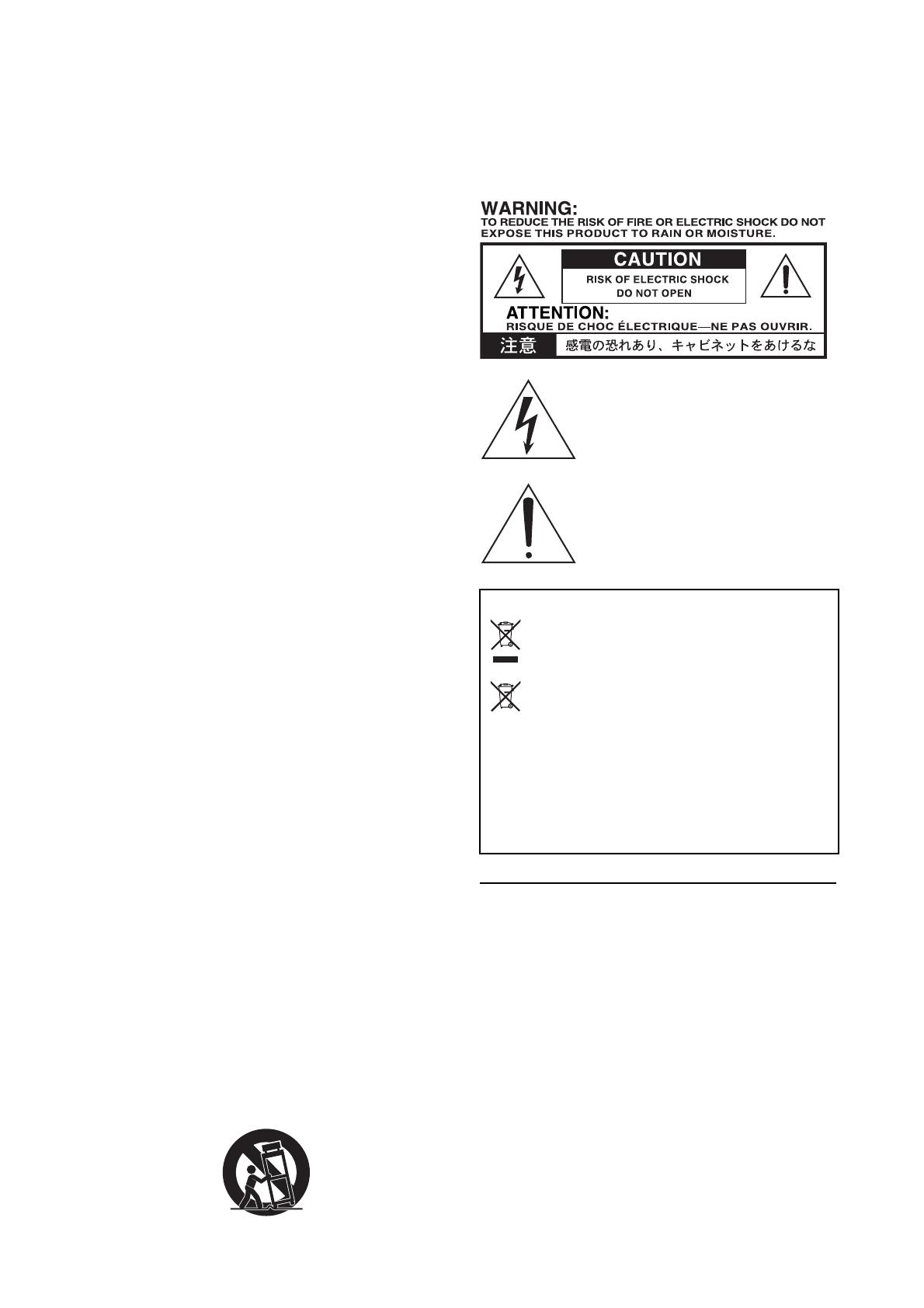
14
INFORMATIONS IMPORTANTES DE SECURITE
• Lisez attentivement ces instructions.
• Veuillez conserver ces instructions.
• Observez tous les avertissements.
• Suivez toutes les consignes à la lettre.
• N’utilisez jamais cet appareil dans un endroit humide ni à
proximité d’eau.
• L’appareil alimenté par courant électrique ne peut pas être
exposé à des éclaboussures; évite en outre de placer des
récipients contenant des liquides, comme un vase (ou un
verre de bière), sur l’appareil.
• Nettoyez uniquement l’appareil avec un chiffon doux et sec.
• Ne bloquez jamais les orifices de ventilation de l’appareil et
installez-le toujours conformément aux instructions du
fabricant.
• N’installez jamais l’appareil à proximité d’une source de
chaleur, telle que des radiateurs, poêles ou tout autre
dispositif (y compris des amplificateurs) générant de la
chaleur.
• N’essayez jamais de contourner le dispositif de sécurité d’une
prise de type polarisée ou d’une prise de terre. Une prise dite
polarisée dispose de deux broches, dont l’une est plus large
que l’autre. Une prise de terre comporte trois broches, dont
une de mise à la terre. Cette broche plus large ou broche de
mise à la terre vise à assurer votre sécurité. Si la fiche du
cordon d’alimentation ne correspond pas au type de prise de
courant de votre région, faites remplacer la prise obsolète par
un électricien qualifié (pour les Etats-Unis et le Canada).
• Placez toujours le cordon d’alimentation de sorte qu’on ne
risque pas de marcher dessus ni de le pincer. Cette
précaution vise tout spécialement la fiche du cordon et sa
sortie de l’appareil.
• Utilisez exclusivement les fixations/accessoires préconisés
par le fabricant.
• S’il y a risque d’orage ou que vous ne comptez pas utiliser
l’appareil pendant une période prolongée, débranchez-le du
secteur.
• La mise sur OFF de l’interrupteur d’alimentation n’isole pas
totalement ce produit de la ligne secteur; aussi, retirez la fiche
de la prise s’il doit rester inutilisé pendant une période
prolongée.
• Installez ce produit près de la prise électrique murale et
gardez un accès facile à la prise électrique et au cordon
d’alimentation.
• ATTENTION: Cet appareil doit absolument être connecté à
une prise électrique reliée à la terre.
• Confiez tout travail de réparation uniquement à un S.A.V.
qualifié. Faites appel au S.A.V. si l’appareil a subi tout
endommagement, comme par exemple si sa fiche secteur ou
son cordon d’alimentation sont endommagés, si de l’eau ou
des objets ont pénétré à l’intérieur de l’appareil, si celui-ci a
été exposé à la pluie ou à la moisissure, s’il est tombé ou
présente tout signe de dysfonctionnement.
• N’utilisez jamais d’allonge trop longue avec cet appareil et ne
l’alimentez jamais via les prises secteur équipant d’autres
dispositifs.
• N’installez jamais cet appareil dans un endroit confiné comme
une caisse de transport ou tout autre récipient similaire.
• Des niveaux d’écoute trop importants lors de l’utilisation d’un
casque ou d’écouteurs peuvent entraîner des pertes
d’audition.
• Utilisez l’appareil uniquement avec le chariot, stand, trépied,
fixation ou table spécifiés par le fabricant ou fourni avec
l’appareil. Si vous avez placé l’appareil sur un chariot, soyez
très prudent quand vous déplacez le chariot, afin d’éviter une
chute et des blessures.
• Cet instrument est conçu pour être utilisé dans des régions au
climat tempéré et ne convient pas pour les pays au climat
tropical.
• Veillez à ne jamais bloquer les orifices de ventilation en les
couvrant d’objets tels que des journaux, nappes, rideaux, etc.
• Ne placez aucune source de flamme nue, telle qu’une bougie
allumée, sur l’instrument.
L’éclair dans le triangle est un symbole destiné à
attirer l’attention de l’utilisateur sur la présence de
parties non isolées et de “tension dangereuse” à
l’intérieur de l’appareil, qui posent des risques
d’électrocution pour l’utilisateur.
Le point d’exclamation dans un triangle est un
symbole destiné à attirer l’attention de
l’utilisateur sur des sections de ce manuel
contenant des informations importantes, liées
à l’utilisation et à l’entretien de ce produit.
* Tous les noms de produits et de sociétés sont des marques
commerciales ou déposées de leur détenteur respectif.
Note concernant les dispositions (Seulement EU)
Quand un symbole avec une poubelle barrée d’une
croix apparait sur le produit, le mode d’emploi, les
piles ou le pack de piles, cela signifie que ce produit,
manuel ou piles doit être déposé chez un
représentant compétent, et non pas dans une
poubelle ou toute autre déchetterie conventionnelle.
Disposer de cette manière, de prévenir les dommages
pour la santé humaine et les dommages potentiels pour
l'environnement. La bonne méthode d'élimination dépendra
des lois et règlements applicables dans votre localité, s’il vous
plaît, contactez votre organisme administratif pour plus de
détails. Si la pile contient des métaux lourds au-delà du seuil
réglementé, un symbole chimique est affiché en dessous du
symbole de la poubelle barrée d’une croix sur la pile ou le
pack de piles.




















